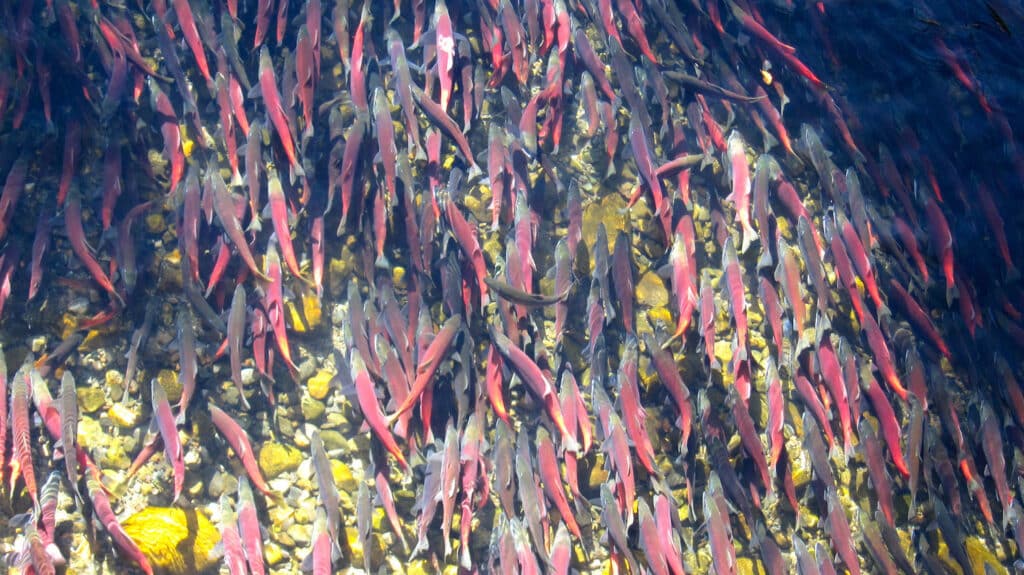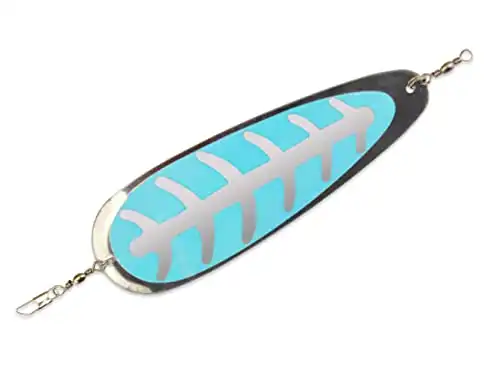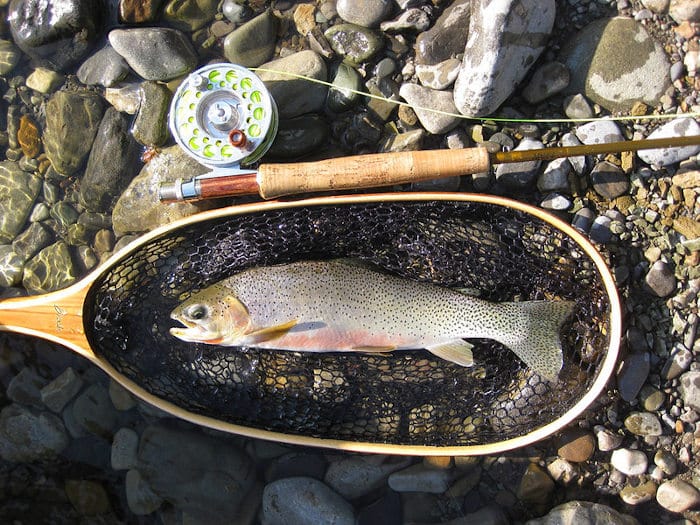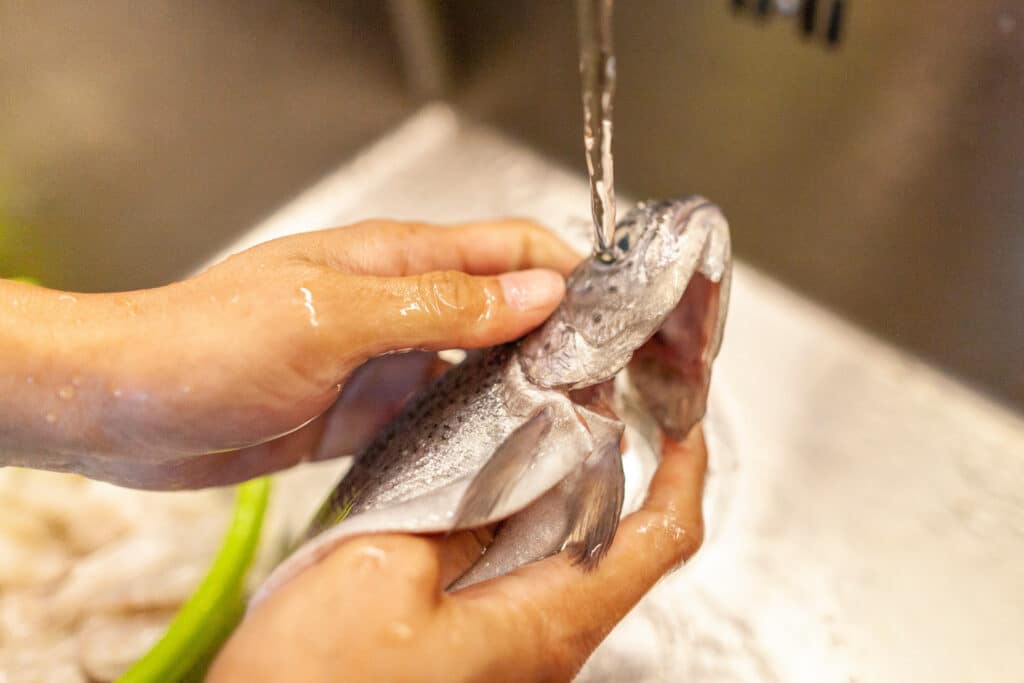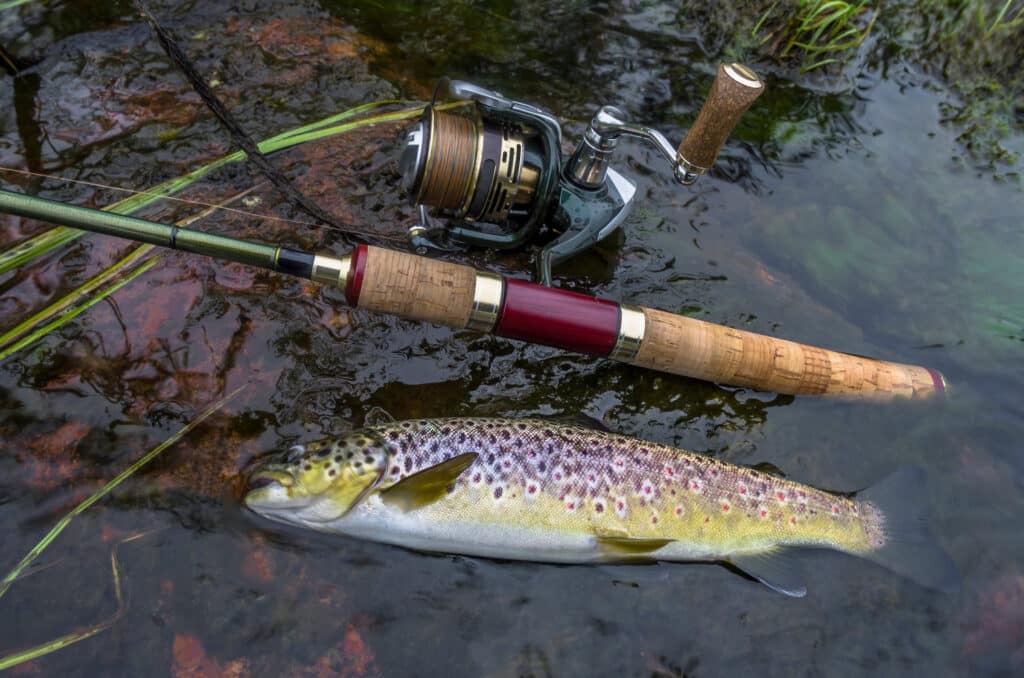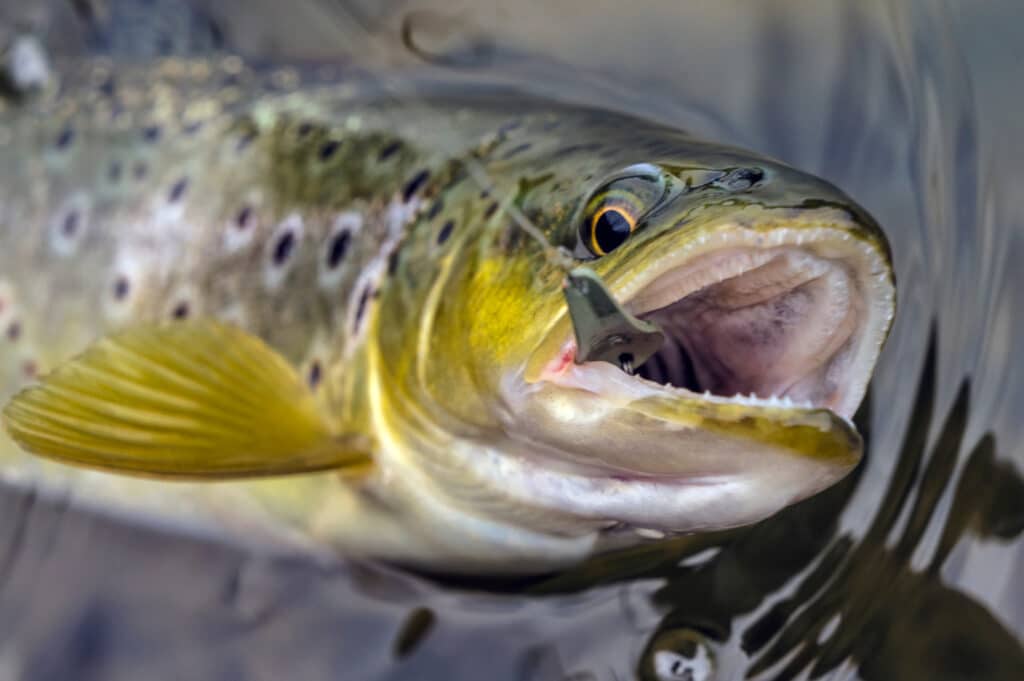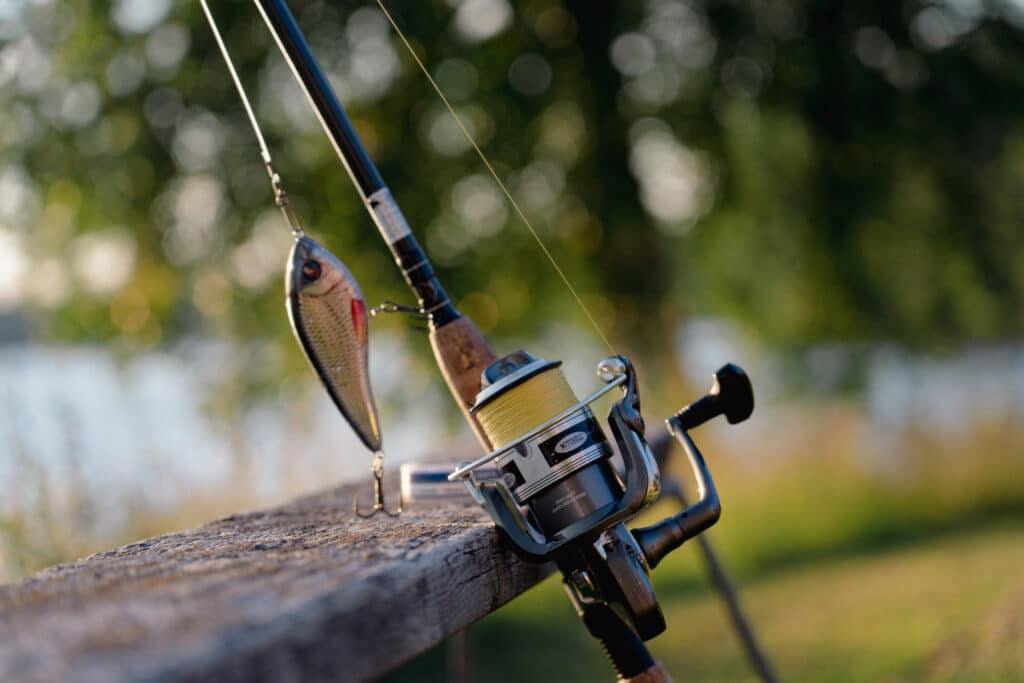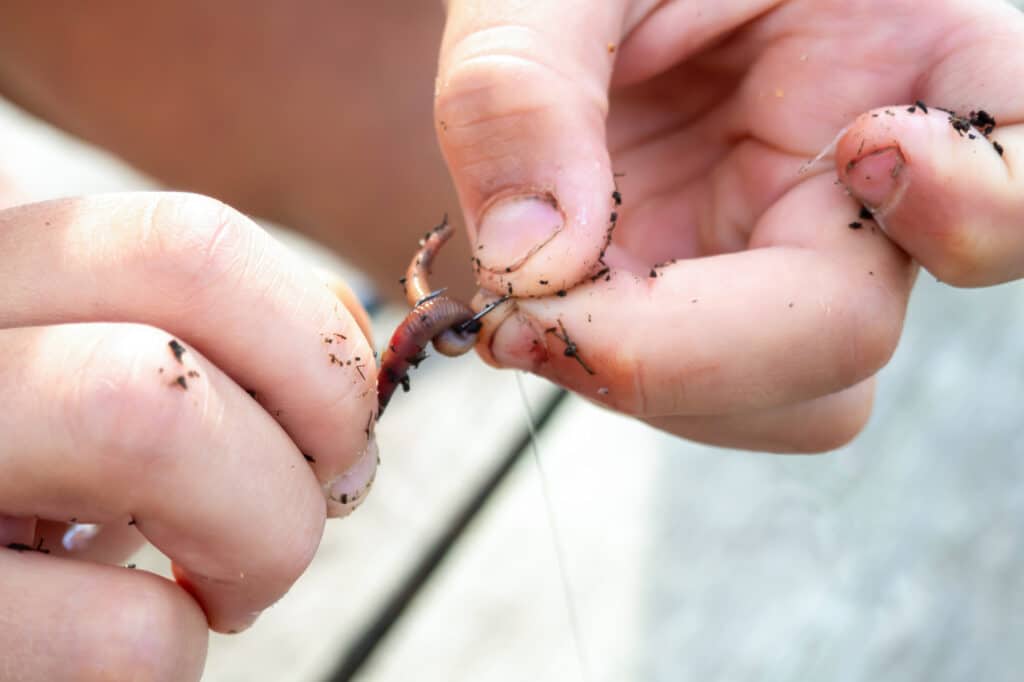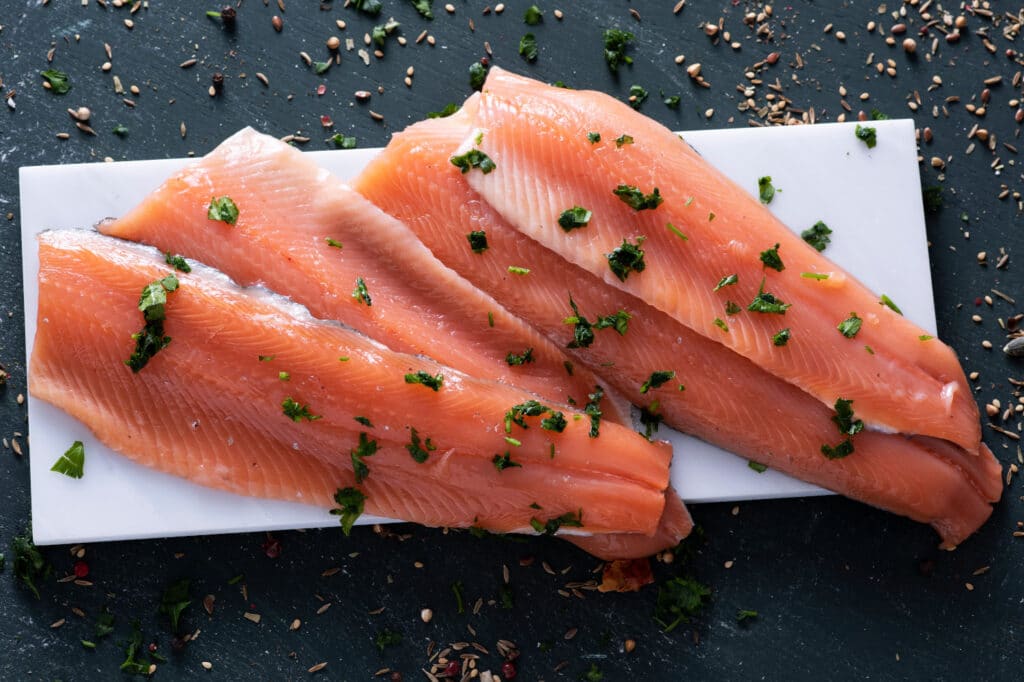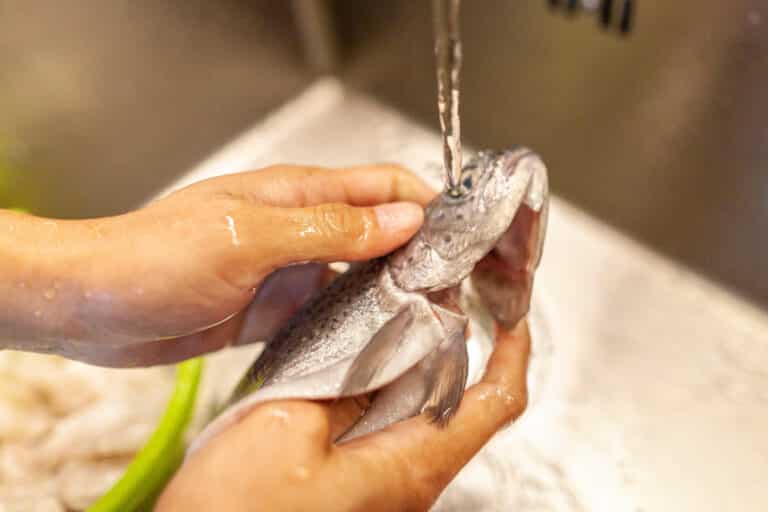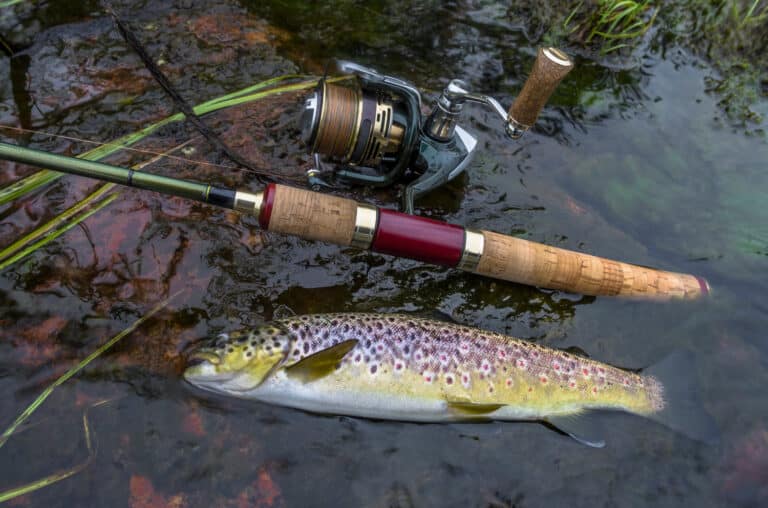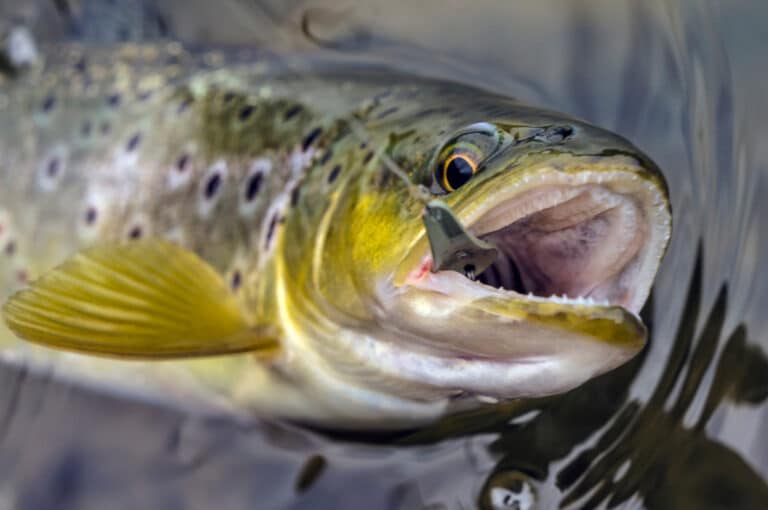There’s nothing that inspires obsession in the Inland Northwest quite like kokanee. If I go to my local kokanee lake on an early June morning, there will be dozens of boats, slowly cruising its points and dropoffs. And though our lakes have plenty of worthwhile species, they’re all after just one fish: kokanee salmon.
If you’ve ever wanted to fish for kokanee but don’t know where to start, you came to the right place. In this guide, I’ll go over the basic kokanee trolling setup, including rods, reels, downriggers, and lures. I’ll also share some hard-earned tips on how to adjust when these finicky fish aren’t biting.
I also know that the budget doesn’t always allow for fancy equipment, so check out this video for tips on trolling for kokanee without downriggers.
By the time you finish reading this, you’ll have all the information you need to start trolling for kokanee. Kokanee are some of the best eating freshwater fish, too, and they’re even great for making your own sushi. If you want to skip to a particular section, use the table of contents below to find what you’re looking for.
The Wild Provides is a participant in the Amazon Affiliate program. If you click through one of the links on this site and make a purchase, we may receive a small commission at no extra cost to you. It helps to keep us up and running, but all recommendations are my own honest opinions.
Kokanee Salmon: Understanding The Species
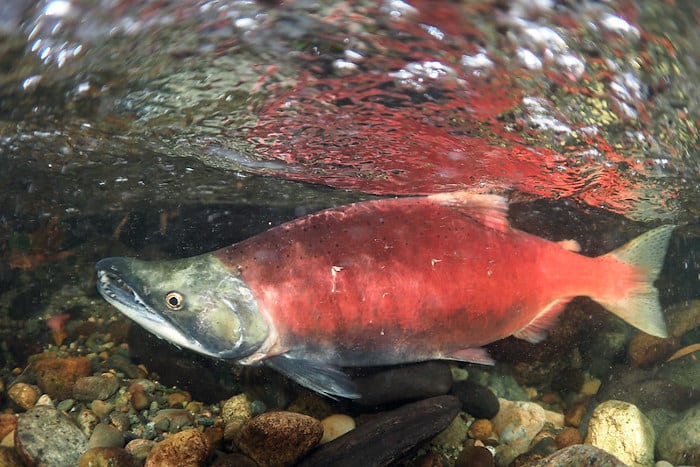
I’m a firm believer that if you want to catch any fish, you need to know about its behavior. Food sources, life cycle, and habitat preferences all come into play, and kokanee tactics are especially unique to their life cycle.
Kokanee salmon are just that: salmon. They may be landlocked, but these inland sockeyes still behave just like their ocean-going cousins. They live in lakes and migrate up rivers to spawn, dying at the end of the cycle.
Kokanee have a lifespan of anywhere from 2-7 years (though it’s usually around 4), spending their adult life cruising lakes and looking for food. Because food isn’t as available in lakes as it is in the ocean, kokanee typically reach anywhere from 9-12 inches long and weigh around a pound (though the record is 9 pounds 10 ounces!).
Don’t be fooled by their size, though; kokanee are aggressive, hard-fighting fish, and they’ll jump, roll, and fight you just as hard as their bigger cousins.
Another key thing to know about kokanee is that they school up in large numbers. They’re also very temperature specific, preferring water temps of around 53 degrees. That means finding them isn’t all that hard; you’ll be able to see them on your fishfinder, and they’ll usually be near the thermocline (more on the thermocline below).
What Do Kokanee Eat?
Unlike most freshwater gamefish, kokanee salmon are filter feeders. Kokanee eat tiny zooplankton and other invertebrates, filtering them through structures called gill rakers. This is important to know because it means trying to catch them on bait won’t do you any good.
The key to triggering a kokanee to bite is actually to anger them, putting something flashy and annoying right in their face. If you do it right, their aggression will get the better of them and you’ll have a kokanee on the line.
But what do you use to make them angry? Read on for the kokanee trolling setup.
Kokanee Trolling Setup: Required Gear
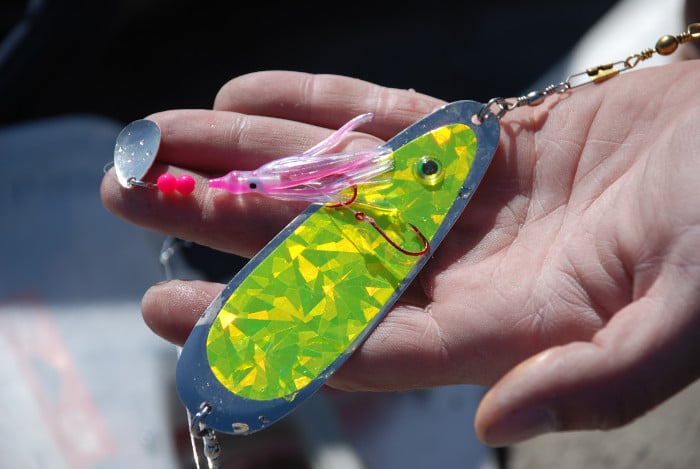
Kokanee trolling requires a little bit more tackle than other types of fishing. You’ll need dodgers or flashers, lures, a downrigger (usually), and something with a little scent to tip your hooks with.
Luckily, losing kokanee tackle is rare, and you can expect everything to last a long time. Getting your limit on a single dodger/lure combo is doable, but it always helps to have a few colors and styles. Kokanee can be finicky fish and flexibility is important.
There are three basic components of any kokanee trolling setup: an attractor, a lure, and a scent.
Attractors: Dodgers, Flashers, And Lake Trolls
If you’re unfamiliar with salmon trolling, dodgers and flashers are the most unique part of the setup. They’re big, square, flashy things that don’t have their own hooks. But they’re absolutely essential to kokanee fishing, and I’ll explain why.
The purpose of the dodger isn’t to actually get bitten. Its purpose is to attract the attention of nearby fish, piquing their curiosity and drawing them closer. Then when a small lure follows behind it, the kokanee is (hopefully) annoyed enough to attack.
Dodgers are designed to sway side-to-side in the water, slowly swinging back and forth and creating vibrations that kokanee are attracted to. Flashers are designed to stay put and spin, flashing and spinning faster than a typical dodger.
In today’s kokanee world, dodgers are far more popular than flashers. Because kokanee are low on the food chain, the more aggressive vibration of a flasher will spook them. It triggers alarm bells that a predator is nearby, and that’s the last thing you want while fishing for them.
Kokanee dodgers are 4-5 inches long and you can find them in every color of the rainbow. Having a variety of colors on hand is always a plus, but simple is usually effective; silver or bronze dodgers get the job done. If you want to go all out, get some UV reds, pinks, and oranges too.
An alternative to both of these is to use what’s called a “lake troll” (though many people call them “cowbells”, after Luhr-Jensen’s branded model). These are strings of large spinner blades that spin, flash, and vibrate in the water, mimicking schools of baitfish.
Lake trolls are the old-school method, and seeing them actually used anymore is rare. But in my personal experience, cowbells and generic lake trolls often work just as well as dodgers, and sometimes (like in early spring) they can be much better. Having one with you might just make the difference between getting skunked and getting your limit.
Here are a few of the best dodgers for kokanee fishing:
Mack’s sling Blade 4-Inch Dodger
Mack’s Sling Blade is one of the best dodgers on the market for any kind of salmon trolling. The 4-inch sizes are perfect for kokanee, and their UV Series provides extra visibility in dark water. Pink/Glow and UV Pink are my favorite colors.
Mack’s Double D 4.4 Inch Dodger
Mack’s Double D Dodger has a classic dodger action, but they also have multiple front attachment points. Changing where you clip the front swivel makes them act like side-planers, and they’ll pull your lines away from the boat for a wider spread. If I could only have one color it would be Hot Pink, but Lemon Lime UV is a close second.
Luhr Jensen Cowbell Troll
Kokanee Lures
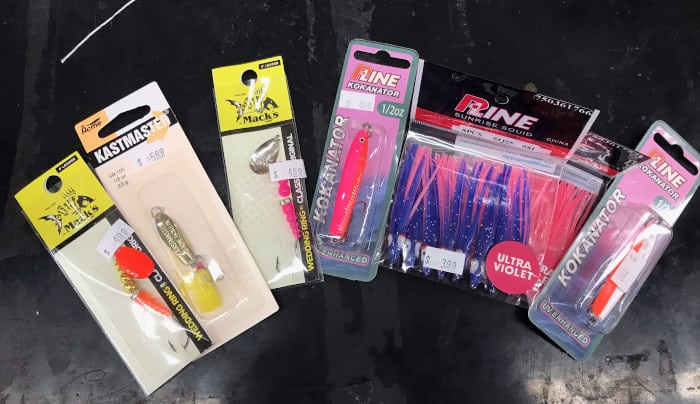
Now for the part of the setup that the fish actually bite: the lure.
Small lures trail a short distance behind the dodger, so that when the fish moves toward the dodger to investigate, the lure will end up right in their face. If all goes well, this will annoy them enough to trigger a bite!
There’s a huge variety of kokanee lures out there. While many of them can work well, it’s important to know that they fall into two categories: lures with no action, and lures with their own action. Popular Lures with no action include hoochies, wedding rings, and really any kind of spinner. Popular lures with action are things like kokanee cut plugs, wiggle hoochies, and spoons (more on my favorite lures below).
With either lure type, leader length is important. Follow these rules for the best chance of success:
Lures with no action should be run close to the dodger, roughly twice the length of the dodger itself (usually 6-10 inches). This is the strike zone; the spot where curious kokanee will end up when following a dodger.
Lures with their own action should be run further back so the action of the dodger doesn’t affect the action of the lure. The distance here can vary, but you should at least give it twice as much leader as a lure without action (anywhere from 18-24 inches).
Again, tons of different lures can work well for kokanee. The more important thing to think about is color.
Kokanee, much like salmon, are most attracted to a particular range of colors. The best colors are pinks, reds, and oranges, and UV and glow options can be killer in deeper water. Though kokanee undoubtedly love the redder end of the spectrum, there are also some days when chartreuse is even more effective.
Having a range of colors on hand is more important than having a range of different lure styles. That said, you should try to keep a few different options on hand to switch it up if the fish aren’t biting.
If you’re brand new to kokanee fishing, here are some of the most tried and true lures to add to your tackle box:
Mack’s Wedding Ring
If you’re going to buy just one lure for kokanee, buy a wedding ring in hot pink and silver. These are some of the oldest and most popular kokanee lures, and there’s a good reason why: they just flat-out catch fish.
Rocky Mountain Lures Signature Squid
Dick Nite Spoon
Spoons are some of the most versatile lures in fishing, and they’re perfect for kokanee too. Dick Nite makes the kokanee angler favorite, and their range of sizes and colors is wide enough to catch them on any day. As always, pink and red are the favorites (but keep a chartreuse on hand as a secret weapon).
Bait And Scent
We’ve already established that kokanee are filter feeders, so why are bait and scent important?
Bait and scent aren’t absolutely essential, but they can be the one thing that seals the deal. Kokanee live by their nose – they are salmon after all – and adding scent does a couple of important things.
The first is providing another level of realism to the lure. If the lure is meant to imitate something the kokanee might actually find in nature, then it should smell like it, too.
The second is covering up the human scent that we leave on the lure. You may not be able to smell it, but your hands leave oils all over the lure that leave a scent trail for the fish. They might not know you as a predator (yet), but they’ll know something is off, and this can dissuade them from biting.
The most popular kokanee bait/scent by far is a single piece of white shoepeg corn, either natural or dyed and scented. Why it works so well is unclear, but it’s the tried and true kokanee bait and it can make a huge difference.
You can buy pre-scented corn (like Pautzkes Firecorn) or make your own, but popular scents include krill, salmon egg, and tuna. Anise and garlic can also be killer (learn more about why anise is popular for fishing here).
Aside from corn, Berkeley Gulp! maggots and waxworms (or real maggots and waxworms) are also popular.
The bait isn’t the star of the show; a single piece of corn or a single maggot on the tip of the hook is enough. But scent can make or break your fishing day, so always keep something on hand.
Pautzke’s Firecorn – Pink
Berkley Gulp! Maggots
I use Berkley Maggots for ice fishing more than anything, but they’re just as effective when catching kokanee. Even though corn is my bait of choice, I keep a container of these around for days when the fish just don’t want to bite.
Other Gear: Rods, Reels, and Downriggers
Rods, reels, and downriggers are the other required pieces of equipment (aside from a boat, of course).
Rods
You can use anything you have on hand to troll for kokanee, but an ideal rod will have a light action and be 7-8 feet long.
Light action alone is enough, but “noodle” rods are the way to go for kokanee trolling. These rods bend easily not just at the tip, but all the way through to the handle. When you pick them up they’ll feel wiggly and loose, requiring very little force to bend them.
Landing kokanee once they’re hooked can actually be the most difficult part of catching them, and noodle rods give you the best chance. A good noodle rod keeps the hook pinned in the kokanee’s mouth while giving it plenty of leeway to fight without breaking off. These soft-mouthed, feisty fish are notorious for figuring their way out of quality hooksets, and a good rod will help prevent that.
The best kokanee rods are made of fiberglass, though well-made graphite rods can work well too. There are tons of options, but I personally recommend the Okuma Kokanee Black in either 7’6″ or 8′, or the Lamiglas Kokanee and Trout Trolling Rod in either 7’6″ or 8′. Both are around 100 bucks on amazon and are perfect for trout or kokanee trolling.
Reels
Though you can use a spinning reel for trolling, level-wind reels (also known as baitcasters) are the way to go. They’re easier to let line out with when dropping a downrigger, and a good line counter reel will allow you to really keep track of how far your lure is from the boat.
Any level-wind reel will work well. Reels with line counters are a big plus, but aren’t required.
A couple of my favorite value reels are the Daiwa Lexa LC100 and the Okuma Coldwater 203. Both offer a solid bang for the buck, and all the features you need to successfully fight and catch even the biggest kokanee.
Downriggers
Though there are ways to catch kokanee without downriggers, they give you a huge advantage.
Kokanee are usually found in deep water, often deeper than 60 feet. A downrigger allows you to use heavy weights to get down to depth and stay there, but break free from that weight when you hook a fish. Because kokanee trolling is usually slow speed, a 4-6 pound ball is plenty to get you down.
Downriggers can cost more than 1000 dollars, but you can get a cheap, functional Scotty downrigger for about 75 bucks. It’s a manual crank and it isn’t fancy, but it’ll get the job done.
Fish Finder
A fish finder is (unfortunately) the most expensive and most useful part of a kokanee trolling setup.
Because kokanee school up at specific depths, trying to find them without a fish finder is like trying to find a needle in a haystack. With a fish finder, you can easily pick up schooling fish. The more money you’re willing to spend, the better off you’ll be. But even the cheapest fish finders give you enough information to find kokanee.
With that said, I first started fishing for kokanee without a functional fish finder. Kokanee fishing is a pretty inclusive community, so local tackle shops are often willing to give out some intel. The depth where kokanee hang out changes with the seasons, but it tends to be pretty uniform across a lake. If you can figure out how deep they are, you can catch kokanee.
How To Rig The Kokanee Trolling Setup
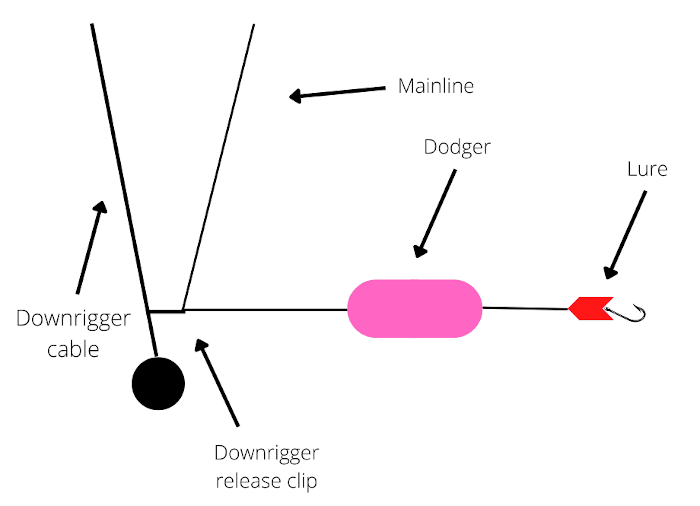
Rigging up for kokanee is a little more complicated than other freshwater tactics, but it’s really not all that difficult. Here are the steps:
- Tie a bead chain swivel to the end of your mainline (optional; helps reduce line twist)
- Tie 18-24 inches of 6-8 pound test monofilament leader to the swivel
- Tie the leader to the front swivel on your dodger or lake troll
- Tie another length of 6-8 pound leader to the terminal side of the dodger (length depends on the lure, as described above)
- Tie that leader to your lure. If your lure of choice has its own action, you may want to tie your leader to a snap swivel and then clip that to the lure.
Use the diagram above to help you tie up your rig. Before you clip into your downrigger, let out 20 to 30 feet of line to keep your presentation well behind the boat. Boat noise can spook kokanee, so keeping your lure relatively far back can help you get more hookups.
Where To Fish For Kokanee: How To Locate Schools
If you have a fish finder, locating kokanee is a fairly simple process. Kokanee will be found around food, and food is often found around structure. Think points, dropoffs, and river mouths.
Those are the spots to start your search, but when you get there your fish finder is your guide. Ideally, you’ll be able to see schools of fish concentrated at a specific depth. If you find fish, that depth and location are where you should start trolling.
If you don’t actually see fish, but you have reason to believe they’re there (either because other boats are trolling nearby or you have some local intel) trolling the thermocline is your best bet. I’ve caught kokanee without ever marking fish, all by trolling at the thermocline.
The thermocline is the depth where cold, dense water separates from the warmer water above. There can be a 10-degree temperature difference in as little as 5 feet, and this is where both kokanee food sources and kokanee themselves are likely to be found.
The thermocline is usually easy to spot on a fish finder. It will show up as a thick, horizontal line, well above the actual bottom of the lake. This is where food sources tend to suspend, and is therefore where kokanee are often found.
Kokanee Trolling Tips and Techniques
Kokanee trolling is similar to any other type of trolling. There are a few tips and tactics though that reliably put more fish in the cooler, and they’re specific to kokanee.
Tip #1: Troll Very Slowly
One important thing to know about kokanee trolling in particular is that slow speeds are crucial. While trout can be caught at speeds as high as 3 miles per hour, the sweet spot for kokanee is around 1.2 miles per hour. Sometimes you’ll need to go even slower than that, at a pace that feels like a crawl.
I’ve caught kokanee at as slow as .8 miles per hour, and sometimes just when you think you couldn’t possibly go any slower is when you’ll start to hook up. Other times they hit at faster speeds, as high as 1.5-1.7 mph, but rarely do I catch them going any faster than that.
Tip #2: Switch Up Colors, Lures, and Dodgers Constantly
Kokanee are very finicky creatures. One day they’ll love pink, the next it’s chartreuse. At 8am they’ll hit at 1.2 mph, and by 9 they’ll only bite at 1mph. The biggest piece of advice I can give in regards to kokanee fishing is this: if you know where the fish are but they aren’t biting, change something about your presentation immediately.
There are a number of different factors you could change. Sometimes moving the setup from just below the fish to just above them is the ticket. Other times it could be slowing down or speeding up, while still others it could be switching out your dodger or lure. Even reducing or increasing distance from the boat can be a factor in whether they’ll bite.
Once you hit on the winning combo, stick to it. I find that although it might not work a couple of hours from now, usually one combination works significantly better than the rest.
Tip #3: Troll in S-Curves
One easy strategy that seems to help more often than not is to troll in “S” curves. Slowly swinging from side to side slows your lures down on one side and speeds them up on the other, varying your presentation across the boat. That variation in speed and depth seems to regularly trigger bites.
Trolling in s-curves isn’t always necessary, but on slow days I find that I can pull a few extra bites from fish that are otherwise not willing to commit.
How to Find the “hot Lure”
To streamline the process, I always start a fishing day by trolling as many different setups as I can (others might be more dialed in than me, but I like to give myself room for error). Each line will have a different dodger/lure combo, and I’ll set them at depths that are ever so slightly different (1-2 feet apart). That way I’m testing the highest amount of variables that I can at one time.
Hot Tip: Use Mack’s Double D dodgers to be able to troll more lines. Clipping to one of the outer holes creates an underwater planer board, spreading out your presentation enough for at least four rods.
If I don’t get bites, I’ll reel in and change colors, lures, or dodgers. I’ll change everything out and replace it with another wide range of options until something gets bit.
When I do get bites, I’ll switch all my setups to the one that got bit (and almost always, one setup does significantly better than the rest). Kokanee fishing is always trial and error; the hot lure one day is a bust the next. But that’s what makes it fun, and that’s what keeps us coming back.
Final Thoughts
Kokanee fishing can be a little daunting because there are so many variables. But if you stick to tried-and-true dodgers and lures, and you’re willing to change things when the fish aren’t biting, you’ll have a great shot at success. Be flexible, keep trying, and fish on!

